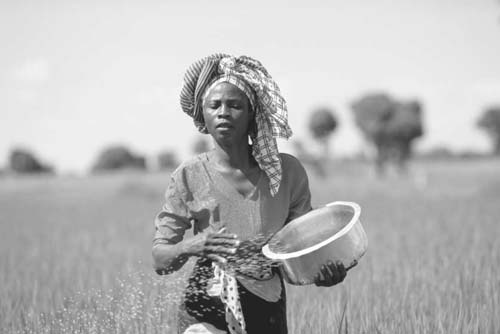Japan's Official Development Assistance White Paper 2006
Main Text > Part I JAPAN'S OFFICIAL DEVELOPMENT ASSISTANCE FOR WORLD PEACE AND PROSPERITY > Summary
Part I JAPAN'S OFFICIAL DEVELOPMENT ASSISTANCE FOR WORLD PEACE AND PROSPERITY

School children cheerfully raising their hands to answer questions (Ethiopia) (Photo: JICA)

A woman working on a rice field (Tanzania) (Photo: JICA)
Summary
Part I reviews the history of Japan's Official Development Assistance (ODA). It also sheds light on specific examples of new missions expected of Japan's ODA and efforts by Japan to fulfill such new missions, which have arisen amidst changes in the international environment in recent years.
Chapter 1 is devoted to the history of Japan's ODA. When it was first introduced in 1954, ODA played a role in reconstructing friendly relations with Asian countries, reinforcing the liberal bloc in the Cold War setting, and promoting exports from Japan. Thereafter, as Japan entered the era of rapid economic growth, its ODA disbursements grew in volume to cover a wide range of segments and regions. During the oil crises in the 1970s, structural adjustment loans became the world's major trend for aid activities. Japan however continued providing project-based assistance in parallel with structural adjustment loans and thus contributed to the remarkable economic development that was dubbed the "Miracle of East Asia." In the 1990s, the Cold War framework collapsed, while increasing attention was drawn to global-scale challenges such as environmental issues. Against this backdrop, Japan established its ODA Charter in June 1992.
From the beginning of the 21st century, Japan's ODA disbursements shrank due to the country's stringent fiscal status. At the same time, emerging countries were gaining economic power, while some global-scale issues were becoming worse. Amidst these moves, the idea of "human security" was proposed in the international community and the United Nations (UN) drew up the Millennium Development Goals (MDGs) in 2000. The terrorist attacks in the United States in 2001 led to the idea that poverty reduction is of extreme importance as poverty is recognized as the breeding ground of terrorism. In response to these developments, Japan revised its ODA Charter in August 2003. The renewed Charter regarded the goals of ODA not only as a contribution to the international community, but also as a help to promote security and prosperity of Japan. In addition, in the future, the strategic use of ODA is expected for purposes such as the promotion of the private sector's economic activities and the securing of resources and energy.
To pursue these missions, Japan took on a fundamental reform of its ODA program in 2006. As a result, the Cabinet Office established a new Overseas Economic Cooperation Council, while the Ministry of Foreign Affairs (MOFA) set up the International Cooperation Bureau. Legal improvements were also made to make the Japan International Cooperation Agency (JICA) the sole implementing organization of ODA's three modes of assistance.
Chapter 2 looks at issues to be fulfilled and tackled by Japan's ODA: reinforcement of friendship ties with other countries and the promotion of understanding for Japan; the importance of trade and investment for development and roles played by ODA; global warming and environmental cooperation; agricultural development; infectious disease; and assurance of maritime security and peacebuilding. Along with this line, the recent development of ODA is overviewed with specific cases.
Chapter 3 focuses on a recent series of ODA reform, referring to a report prepared by the Overseas Economic Cooperation Study Group in February 2006, the establishment of the Overseas Economic Cooperation Council in April 2006, and the foundation of the International Cooperation Bureau at the MOFA in August 2006. The chapter also describes the efforts to reform ODA pursued since 2005, categorized by themes including: strengthening strategic value; strengthening functions of field missions; improving efficiency; strengthening coordination between schemes; strengthening collaboration with other donors and NGOs; efforts to reduce cost; and strengthening measures to prevent misconduct.


 Next Page
Next Page